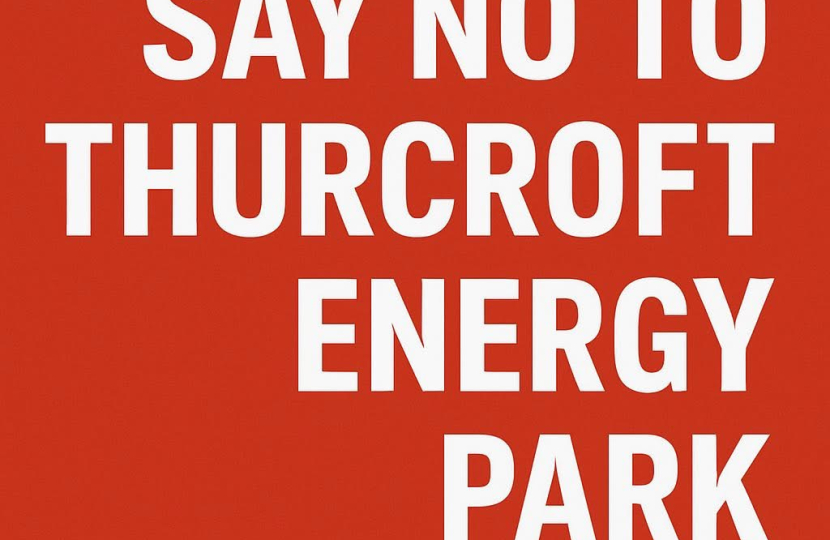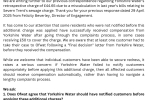
📢 Alexander Stafford MP has submitted his formal objection to the proposed Thurcroft Energy Park – a vast industrial solar and battery development planned for farmland near Wickersley and Thurcroft.
The developer is asking the council to ignore the huge Whitestone project already in the national planning process and overlook the wider, cumulative impact on the local area. Alexander believes this is unacceptable.
⚠️ The proposals include:
🔋 Industrial-scale solar panels and battery storage
🌿 A small patch of “nature” to tick a box
🌾 All at the cost of destroying productive farmland and countryside
Alexander is clear:
✅ “The Government must support a sustainable future for farmers and prioritise our food security. We simply cannot afford to keep losing farmland – and we must stop pushing farmers into seeing solar as the only viable future for their businesses.”
This is about:
🥕 Protecting our food security
🇬🇧 Supporting British farmers
🏡 Defending our countryside
✋ Challenging overdevelopment
💬 The final decision lies with RMBC’s Labour-run planning committee. This is a serious test for Jake Richards MP, who previously said no more energy projects should proceed until the full scale of Whitestone is understood. If Labour says one thing and does another, local people will see straight through it.
📢 Residents can make their voices heard by submitting a comment here:
👉 https://planning.rotherham.gov.uk/fastweblive/detail.asp?AltRef=RB2025/…
Let’s send a clear message: No more solar land grabs. Enough is enough.
#FoodSecurity #BackBritishFarming #SaveOurCountryside #StopThurcroftEnergyPark #Wickersley #Thurcroft #AlexanderStaffordMP
Alexander’s objection is below: 👇
I submit this formal objection to planning application RB2025/0714 concerning the proposed development of a 102-hectare ground-mounted solar energy park on Green Belt land off Morthen Lane, Thurcroft.
This development is unsuitably located, disproportionate in scale, and fails to properly address the cumulative environmental and social impacts it will bring to the communities of Thurcroft, Whiston, Wickersley, and surrounding rural areas. The application must be refused for the following reasons:
⸻
1. Misuse of Protected Green Belt Land
The applicant’s claim that this constitutes a “temporary” and “reversible” development undermines the principle of long-term Green Belt protection. The development would industrialise over 100 hectares of open countryside with steel structures, security fencing, substation compounds, battery containers, and hard-surfaced access roads. It will fundamentally and visibly alter the character of the area for at least 40 years.
According to the submitted Agricultural Land Classification report, over 35% of the site (grades 2 and 3a) falls within the category of Best and Most Versatile (BMV) land, which is explicitly protected under national planning policy .
Allowing development of this scale on productive farmland would set a dangerous precedent, especially when alternative brownfield or rooftop options have not been properly prioritised or explored in sufficient depth .
⸻
2. Cumulative Impact with Whitestone Solar Farm – Must Not Be Ignored
While this application is for a separate development, the applicant’s attempts to downplay or disregard the relevance of the nearby Whitestone Solar Farm proposal are disingenuous.
Whitestone and Thurcroft, though technically separate applications, are part of a broader land-use transformation occurring within a narrow geographical corridor. Together, these schemes threaten to create a continuous industrial solar zone covering thousands of acres of Green Belt and rural countryside in Rotherham and Doncaster.
To consider this scheme in isolation contradicts the principles of good planning practice, and directly ignores the National Planning Policy Framework’s guidance to assess “cumulative landscape and visual impacts” for renewable energy proposals.
⸻
3. Landscape, Heritage and Visual Harm
The applicant’s own assessments acknowledge significant visual impact from key Public Rights of Way and residential properties, including Pinch Mill Lane and Morthern Hall Lane . The construction of solar panels up to 3 metres high, fencing up to 2.5 metres, battery units, and 4-metre CCTV poles will urbanise a tranquil rural setting.
This visual intrusion is not mitigated by landscaping alone. The sheer expanse and configuration of the development cannot be screened in a way that preserves existing views or character.
Furthermore, the historic rural setting around Whiston and Wickersley, including nearby conservation areas, will suffer irrevocable visual harm.
⸻
4. Traffic, Access and Highway Safety Risks
During construction, the proposal anticipates nearly 1,800 HGV movements, including articulated lorries and tipper trucks, accessing rural roads unsuited for industrial traffic . Even with mitigation, this poses unacceptable risks to local safety, particularly along Pinch Mill Lane and Morthern Hall Lane, which are narrow, partially unlit, and shared with pedestrians and equestrians.
The area’s rural road network cannot support this volume of traffic without significant disruption, increased risk of accidents, and erosion of local amenity.
⸻
5. Community Engagement and Public Opposition
The Statement of Community Engagement claims extensive outreach, but multiple residents remain unaware or poorly informed about the full scale and impact of the scheme . While consultations were held, the design was not meaningfully reduced or relocated in response to concerns.
Feedback from residents—including those living adjacent to or overlooking the site—shows strong and reasoned opposition to the industrialisation of this landscape.
The Council has a democratic duty to heed the views of those it represents.
⸻
6. Failure to Prioritise Better Alternatives
The developer admits that brownfield land is “limited” rather than unavailable. It is not credible to argue that such a vast scheme is necessary on this particular location, when Rotherham’s wider urban and commercial areas offer potential rooftop and underused land for distributed solar deployment .
⸻
CONCLUSION
This proposal contravenes national and local policy protections for the Green Belt, fails to avoid BMV agricultural land, imposes unacceptable harm on the landscape and rural communities, and deliberately dismisses cumulative planning considerations with other large-scale solar farms.
The Council must reject this application.
I urge the Planning Board to stand with residents and uphold Rotherham’s planning integrity by refusing application RB2025/0714.
Yours sincerely,

